Curly Hair Transplant: Techniques, Benefits, and What to Expect

What is a Curly Hair Transplant?
A curly hair transplant is transplanting healthy hair follicles from a different area of the scalp, typically the back or the sides, into thinner or balding areas. Although the transplant procedure is the same in principle in all hair transplants, curly hair requires extra precision. Unlike straight hair, curls continue beneath the skin, so the natural shape of the follicle must be preserved during extraction and implantation. Success depends on maintaining the hair’s natural curl pattern and density, which is why choosing a specialist experienced with curly and coiled hair is crucial. Improper handling can lead to unnatural growth or damage to the follicles.
Benefits of a Curly Hair Transplant
Choosing a hair transplant for curly hair offers several unique benefits:
- Natural volume: Curly hair naturally covers more scalp per strand, requiring fewer grafts to achieve a naturally full look.
- Permanent results: Once transplanted, hair continues to grow for life, just like the original follicles.
- Restored confidence: Most patients experience a significant boost in self-esteem after regaining their natural curls.
- Custom results: Specialists can design a hairline that complements your curl pattern and facial structure, ensuring the most natural-looking outcome.
- Increased styling options: With restored curls, individuals can enjoy more versatility in hairstyles, from short cuts to big curls, without worrying about sparse areas.
- Long-term cost efficiency: With permanent results, patients spend less on hair products, salon visits, and temporary solutions, making curly hair transplants a cost-effective investment over time.
Why Curly Hair Transplants Are Unique?
Curly hair grows in curved or spiral follicular units under the skin. This distinct structure makes the extraction and implantation process more delicate than with straight hair. For example, African and Afro-textured hair often has fewer follicular units per square centimeter but thicker, curlier strands that provide excellent coverage. Because of these complexities, specialists performing curly hair transplants must understand how to handle follicles without altering their shape. An inexperienced specialist may damage follicles or implant them at incorrect angles, causing curls to grow in unnatural directions. Choosing a skilled professional experienced in curly hair patterns is crucial for optimal results. At SKIN111, we are experts in curly hair transplants, ensuring natural, beautifully aligned curls.
Techniques Used for Hair Transplant in Curly Hair
There are different techniques applied in curly hair implants with adjustments to accommodate the hair’s curl:
- FUT (Follicular unit transplantation): This involves removing a strip of scalp, separating the follicles, and implanting them into thinning or balding areas. While effective, FUT may leave a linear scar.
- FUE (Follicular unit extraction): Individual follicles are extracted directly using tiny punches. This method is often preferred for curly hair because it avoids a straight scar and allows precise extraction.
- Specialized punches: Custom or curved punches may be used to follow the natural curl beneath the skin, minimizing damage to the follicle.
Each technique has pros and cons, and the choice depends on your hair type, donor area availability, and desired results.
Curly Hair Implants – How They Work?
During curly hair implants, the specialist carefully places follicles at the right angle and direction. This step is crucial for preserving the natural curl pattern. Incorrect placement can cause curls to grow in strange directions, making them appear unnatural. When performed properly, transplanted curls blend seamlessly with existing hair, restoring fullness and natural texture. Advanced techniques also allow hair transplant specialists to replicate the natural density and spacing of curly hair, ensuring a smooth transition between transplanted and natural strands.
Preparing for a Curly Hair Transplant
Preparation is key to a successful curly hair transplant. Here’s what you can expect:
- Consultation: The specialist assesses your donor area to determine how many follicles can be safely transplanted.
- Medical check: Blood tests and scalp health evaluations are conducted to ensure you are fit for surgery.
- Instructions: Patients are advised to avoid smoking, alcohol, and certain medications before the surgery.
- Design plan: A tailored hairline is planned, considering your natural curl pattern, facial structure, and aesthetic goals.
At SKIN111, we offer a complimentary consultation with our highly experienced hair transplant and restoration specialists. During this session, we assess your unique curl pattern, discuss your hair goals, and recommend the most suitable approach to ensure natural, lasting results tailored specifically to you.
Expected Results – Before and After
Recovery and results from a curly hair transplant occur in stages:
- Immediate: Some redness and small scabs may appear in the transplanted area.
- 2–3 Weeks: Transplanted hair may shed for a short period of time, a normal stage of the hair growth cycle.
- 3–4 Months: New curly hair starts to grow from the transplanted follicles.
- 12–18 Months: Full results are visible, with thick, natural curls filling in the treated area.
Patience is essential, as curly hair may require additional time to demonstrate noticeable growth due to its unique texture.
Recovery and Aftercare for Curly Hair Implants
Proper aftercare makes transplanted curls grow strong and healthy:
- Gently wash your scalp according to your specialist’s instructions
- Avoid rubbing, scratching or picking at the transplanted area.
- Sleep with your head slightly elevated to reduce swelling.
- Attend regular follow-ups to monitor healing and progress.
Following a post-care and healthy scalp routine greatly improves results and reduces the risk of complications.
Possible Risks and How to Avoid Them
While curly hair transplants are generally safe, there are some risks:
- Follicle damage: Is possible if the grafts are mishandled. Choosing a reputable clinic with highly experienced surgeon can minimize this risk.
- Scarring: FUT may result in a fine linear scar, whereas FUE is minimally invasive and generally leaves only small, subtle marks.
- Shock loss: Temporary shedding of surrounding hair is normal but typically regrows with time.
- Infection: Rare, but proper hygiene and post-operative care reduce the risk.
Understanding the potential risks and following your surgeon’s guidance can help ensure a smooth and successful outcome.
Conclusion
A curly hair transplant provides a reliable solution for restoring natural curls and enhancing confidence. While the procedure requires extra skill and precision due to the unique structure of curly hair, the results are permanent and highly rewarding. By choosing a qualified surgeon, following pre- and post-operative instructions, and maintaining proper aftercare, you can enjoy a full head of healthy, natural curls. Whether you are considering curly hair implants or a complete hair restoration, advanced techniques make it possible to regain both volume and style without compromising your natural curl pattern.
Most Popular:
-

Sciton HALO vs Sciton BBL
Read More »September 20, 2022 -

What is profhilo, and how is it different from fillers?
Read More »September 20, 2022 -

Body contour solutions from SKIN111
Read More »September 20, 2022 -

Does IV GLUTATHIONE therapy work
Read More »September 20, 2022 -

How can an IV drip help you boost your energy
Read More »September 20, 2022